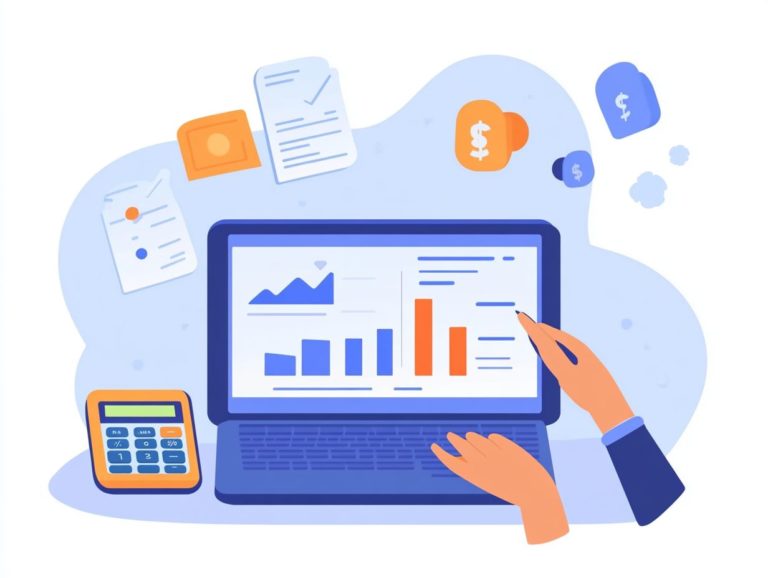Factors Affecting Cloud Cost Management
In today s digital landscape, mastering cloud cost management is essential for businesses like yours that seek to optimize budgets while fully leveraging the capabilities of cloud technology.
This article delves into the key factors that impact cloud costs, including infrastructure, usage patterns, and the choices you make regarding service providers.
It offers best practices for monitoring and optimizing expenses, highlights must-have tools and technologies, and addresses common challenges you may face, along with practical solutions to overcome them.
Let’s dive into this exciting journey as you navigate the intricacies of managing cloud costs effectively.
Contents
- Key Takeaways:
- Factors that Impact Cloud Costs
- Best Practices for Cloud Cost Management
- Tools and Technologies for Cloud Cost Management
- Challenges and Solutions for Cloud Cost Management
- Frequently Asked Questions
- What are the main factors affecting cloud cost management?
- How do usage patterns impact cloud cost management?
- What role does resource allocation play in cloud cost management?
- How does the choice of cloud service provider affect cloud cost management?
- Why is scalability an important factor in cloud cost management?
- How can infrastructure optimization impact cloud cost management?
Key Takeaways:

Understanding the factors that impact cloud costs is crucial for organizations looking to optimize their spending. Implementing best practices such as cost monitoring and key metrics for cloud cost management strategies can help organizations effectively manage cloud costs and avoid overspending. Utilizing the right tools and technologies can greatly assist with cloud cost management, and understanding available solutions is crucial for selecting the best fit for an organization’s needs.
What is Cloud Cost Management?
Cloud Cost Management is the comprehensive strategy you employ to monitor, manage, and optimize your cloud expenditures effectively.
This approach ensures your cloud resources are used efficiently, minimizing unnecessary services and unexpected costs.
It includes strategies designed to achieve operational efficiency, accountability, and accurate expense forecasting within your cloud infrastructure, ultimately enhancing visibility and performance across your cloud resources.
This methodology becomes particularly crucial as you navigate the complexities of cloud economics, where pricing models can be intricate and frequently changing.
Your IT team plays a vital role in using strategies to manage cloud costs, using advanced tools to see costs clearly that deliver real-time insights into resource consumption and expenditure patterns.
Analyze this data to identify trends. This helps you make informed decisions that meet your budget goals. Embracing effective cloud adoption strategies not only ensures prudent resource usage but also fosters agility and innovation, allowing your company to scale operations efficiently without incurring prohibitive costs.
Factors that Impact Cloud Costs
Knowing what drives your cloud costs helps you save money. Elements such as resource usage, service provider selections, and pricing models are key factors in understanding cloud cost management strategies and shaping the overall financial management of your cloud services.
By understanding these variables, you can make informed decisions that enhance your cost efficiency and prepare for cloud cost changes, maximizing the value of your cloud investments.
Infrastructure and Usage
The infrastructure and utilization of cloud resources are pivotal in shaping the overall costs tied to cloud services. To manage expenses effectively, you must diligently monitor your compute, storage, and data transfer needs, and consider how to develop a cloud cost management plan to avoid overspending.
Understanding how these elements interact is essential; overprovisioning compute power can lead to unnecessary charges, while inadequate storage might impede performance. Fluctuations in data transfer rates can quickly increase expenses, especially during peak usage periods.
To mitigate these costs, consider employing strategies such as:
- Auto-scaling, where resources are dynamically adjusted based on real-time demand
- Utilizing spot instances for non-mission-critical tasks
Regularly analyzing usage patterns and implementing cost management tools can significantly enhance your operational efficiency, ensuring that resources are utilized judiciously.
Service and Provider Choices

Choosing the right cloud service provider is crucial for managing cloud costs effectively, and understanding the benefits of cloud cost management can enhance this process. Specialized services also play a vital role.
Providers like Amazon Web Services, Microsoft Azure, and Google Cloud Platform each offer distinct pricing models that can significantly influence your overall expenditures.
By grasping the nuances of these pricing structures like reserved instances and spot instances you can make informed decisions that align with your budget and operational needs.
Reserved instances let you commit to long-term usage at a reduced rate, making expenses predictable. Spot instances are a budget-friendly option for non-critical tasks, often providing savings during off-peak times.
Navigating these models with care can lead to optimized cloud costs, enabling you to allocate resources more strategically while staying compliant with regulatory demands and achieving your operational objectives.
Best Practices for Cloud Cost Management
Implementing best practices for cloud cost management is crucial for elevating your financial management strategies. This approach ensures effective cost monitoring while adopting optimization strategies that align seamlessly with your budgetary constraints and operational goals.
By prioritizing these practices, you can enhance your organization’s financial health and achieve greater efficiency in resource utilization.
Effective Cost Monitoring and Optimization Strategies
Cost monitoring and optimization strategies are essential elements of cloud cost management, enabling you to uncover actionable insights into your spending patterns.
To achieve this, consider using specialized monitoring tools like CloudHealth or AWS Cost Explorer, which can help you track resource utilization and detect trends in your expenditures.
By regularly analyzing these trends, you can optimize your budget by right-sizing your cloud resources, ensuring you re not over-provisioning or using services that don t add real value.
Setting up alerts for unexpected spikes in usage can also help you guard against overspending. Adopting a proactive financial management approach in cloud environments is vital.
It not only enhances your decision-making capabilities but also cultivates a culture of accountability within your organization.
Tools and Technologies for Cloud Cost Management
Leveraging the right tools and technologies for cloud cost management is vital for effectively tracking your cloud spending and understanding how to implement cloud cost controls.
This approach allows you to gain visibility into resource usage and enables you to make informed decisions about your cloud infrastructure, all grounded in the principles of cloud economics.
Overview of Available Solutions

An overview of the available cloud cost management solutions reveals a rich tapestry of options tailored to fit various organizational needs, including how to manage IaaS costs effectively, ranging from budgeting tools to specialized software for managing multi-location cloud resources.
These tools often harness advanced analytics, enabling you to track spending patterns, optimize resource allocation, and forecast future costs with impressive accuracy.
By offering insights into usage trends, they enable you to align your cloud strategies effectively with your business goals.
Some solutions even come with automation features that streamline resource provisioning and de-provisioning, a major advantage for enterprises operating across multiple regions.
As a result, these offerings not only help you maintain financial discipline but also enhance operational efficiency, ensuring that scaling up cloud resources is a seamless endeavor.
Challenges and Solutions for Cloud Cost Management
Be ready for challenges in cloud cost management, like unexpected expenses and compliance hiccups. Tackling these head-on is crucial for your success!
Navigating these complexities requires effective decision-making and strategic planning to ensure success in your initiatives.
Start implementing these strategies today to take control of your cloud costs!
Common Obstacles and How to Overcome Them
Cloud cost management faces common challenges. A lack of visibility into expenses and inefficient resource use can hurt your organization’s efficiency, making it crucial to explore the future of cloud cost management.
These hurdles can cause unexpected financial strain. Underutilized resources and inaccurate workload forecasting often drive up costs.
Plus, different pricing models from cloud providers make it hard to compare and control spending.
To overcome these issues, use visibility tools for real-time insights into resource use and expenses. This helps your teams make informed decisions.
Take a proactive approach by setting budget alerts. Regularly review resource allocations to manage cloud spending better.
Frequently Asked Questions
What are the main factors affecting cloud cost management?

The main factors include usage patterns, resource allocation, and the choice of cloud service provider. To gain a deeper understanding, it’s crucial to learn how to conduct a cloud cost analysis, as scalability and infrastructure optimization also play a significant role.
How do usage patterns impact cloud cost management?
Usage patterns, especially during peak times, can increase cloud service costs. Monitoring these patterns is key to saving money.
What role does resource allocation play in cloud cost management?
Resource allocation is how you distribute computing power and storage. Proper allocation minimizes waste and cuts costs.
How does the choice of cloud service provider affect cloud cost management?
Different providers have different pricing models. Comparing them ensures you find the most cost-effective solution.
Why is scalability an important factor in cloud cost management?
Scalability means adjusting resources as needed. This prevents overpaying for unused resources.
How can infrastructure optimization impact cloud cost management?
Infrastructure optimization involves regularly reviewing your cloud setup. This helps eliminate waste and avoid extra charges.






